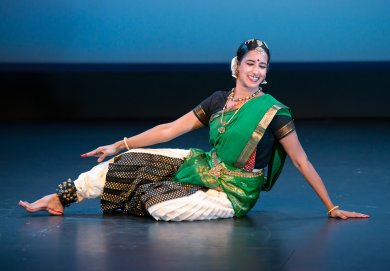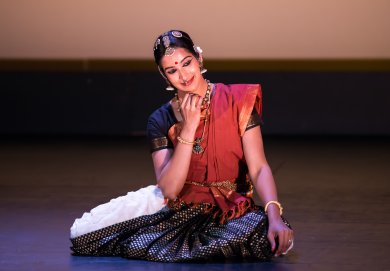 |
 |
Janani Narayananís Panchakanya - Weaving New Destinies - Priya Das e-mail: priyafeatures@gmail.com June 6, 2015 On May 30, Bay Area rasikas were treated to Janani Narayananís first thematic solo, called Panchakanya - Weaving New Destinies. Janani is the Artistic Director of Sunnyvaleís Nrityakalya Dance Company. One has experienced her choreographic work through her students and watched her perform as part of group productions and programs before. Panchakanya gave us a first glimpse into her individual choreographic and dancing talent.  As a theme, Panchakanya presented a rich canvas, and to base a debut
completely on this theme was a courageous choice. Janani chose to
present the stories of Ahalya, Kunti, Draupadi, Tara, and Mandodari
through a traditional Bharatanatyam repertoire. As a theme, Panchakanya presented a rich canvas, and to base a debut
completely on this theme was a courageous choice. Janani chose to
present the stories of Ahalya, Kunti, Draupadi, Tara, and Mandodari
through a traditional Bharatanatyam repertoire.The first item was a new Pushpanjali that introduced us to four of the kanyas. Janani made good use of space and had some innovative combination of hastas with adavus, but it felt as though she was not in her element. The choreography was not consistently vibrant but that was made up for by Jananiís expressive and confident nritta. The sthayi bhava for each heroine was distinct. An item on the fifth kanya, Ahalya, followed. This is where Janani seemed to warm up, presenting a rarely seen Ahalya, who said, ďI was made a wife by Gautama, but Indra made me a woman.Ē Her progression from surprise, hesitation, wonder, and finally desire when Indra comes to her disguised as Gautama was etched out beautifully. The nritta showing both characters was engaging. Janani uninhibitedly showed Indraís lust, kudos to her. The final scene, where Ahalya is shocked at seeing two husbands and her reaction to being cursed was noteworthy. Kunti came to life as she is being wed to Pandu. Jananiís attention to detail was proved by her showing Kunti being nudged playfully into garlanding Pandu. Her innocent attempts at wooing Pandu and then the shock when she understands why he keeps shunning her was moving. Suryaís gentle seduction of Kunti was masterfully done. Kuntiís kutuhalam, hesitation and then giving in were drawn out suitably; the sense of loss at having to let go of Karna was heartfelt. The highlight of this piece was that Janani brought out the irony in Kuntiís life, that she became a mother when she was unwed, but is unable to bear her own husbandís child.  Janani chose to portray Draupadiís story via the popular varnam Innumyen
manam. This was a brilliant and bold interpretation, as was utilizing
the first jathi to present Draupadi being dragged into court and then
her sense of humiliation. The second half of the varnam was also
originally portrayed, with Draupadi drawing parallels between Krishna
robing the gopis or protecting the people, and her own state. A
highlight was when Janani showed Draupadiís surrender using the same
overhead namaskaram as the gopis, which was well thought out. However,
this piece has a high expression quotient, and Janani needs to work at
finessing some of the stronger expressions of disgust and insult. Janani chose to portray Draupadiís story via the popular varnam Innumyen
manam. This was a brilliant and bold interpretation, as was utilizing
the first jathi to present Draupadi being dragged into court and then
her sense of humiliation. The second half of the varnam was also
originally portrayed, with Draupadi drawing parallels between Krishna
robing the gopis or protecting the people, and her own state. A
highlight was when Janani showed Draupadiís surrender using the same
overhead namaskaram as the gopis, which was well thought out. However,
this piece has a high expression quotient, and Janani needs to work at
finessing some of the stronger expressions of disgust and insult.Tara was presented as a javali, a blend of Sarasamuladu and Na saami. This was a clever use of the lyrics; Janani spent some time getting us to know the newlywed Vali and Tara, which was unexpected and charming. It brought a lighter element to an otherwise heavy theme. Choosing to present Mandodari as she is hearing about the death of her son was a master stroke, as it brought the audience into the thick of the story right away. Her anguish at her husbandís insistence on not giving up Sita, and her stoicism to continue serving her land and its people were the highlights of this piece. The Thillana was not at the same level of quality as the other pieces, the pace was slow and the nritta seemed repetitive. Snigdha Venkatramani was the vocalist, her original compositions for most of the pieces must be applauded. The nattuvanar was Chethana Sastry, mridangist was Ravindra Bharathy Sridharan, flautist was Ashwin Krishnakumar; Srividhya Narayan played the veena. A comment must be made about the costumes. The base costume was a contrasting white-black-red, which was striking. Janani had chosen dupattas to delineate each kanya, the dupattas taking the color of the element they represent: Ahalya-air, Kunti-earth, Draupadi-fire, Tara-space, Mandodari-water. Overall, the performance was refreshing. If the thought-through ideation and the expressive story boarding are an indication, Janani shows strong potential to have audiences enthralled in the coming years. Priya Das is a writer based in San Francisco Bay Area, USA, covering extraordinary nuances of everyday life with a focus on the performing arts. She is a regular contributor to India Currents, a magazine reaching more than 170K readers on - and offline. Some of her writing is at www.priyafeatures.com |